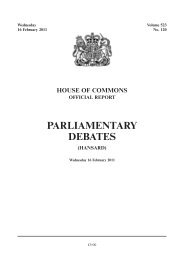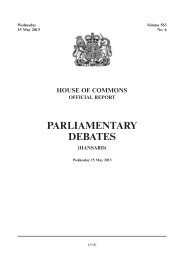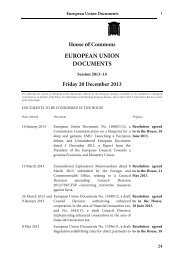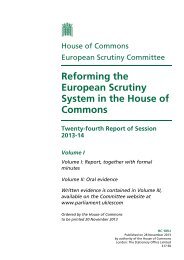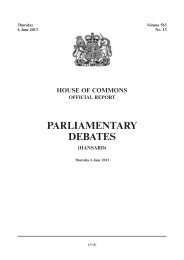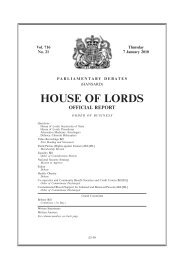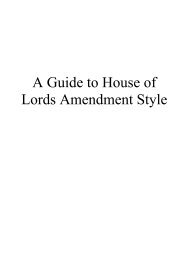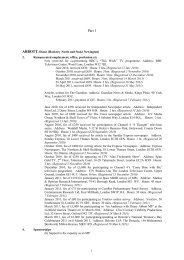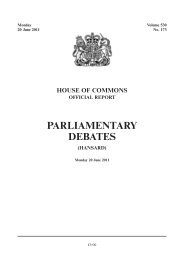View PDF - United Kingdom Parliament
View PDF - United Kingdom Parliament
View PDF - United Kingdom Parliament
You also want an ePaper? Increase the reach of your titles
YUMPU automatically turns print PDFs into web optimized ePapers that Google loves.
173W<br />
Written Answers<br />
26 OCTOBER 2009<br />
Written Answers<br />
174W<br />
2004, 2005, 2006, 2007 and 2008 for toxicology or other<br />
safety/efficacy evaluation in relation to substances used<br />
in the household, was, respectively 1,032, 234, 272, 21,<br />
0, 1, 132.<br />
The available information is published in table 9<br />
(previously table 10) in the Department’s annual publication<br />
Statistics of Scientific Procedures on Living Animals<br />
Great Britain, copies of which are available from the<br />
Library of the House and from the Department’s website<br />
at:<br />
http://www.homeoffice.gov.uk/rds/scientific1.html<br />
Anti-Social Behaviour Orders<br />
Mr. Dai Davies: To ask the Secretary of State for the<br />
Home Department what evaluation he has made of the<br />
cost-effectiveness of the application of anti-social behaviour<br />
orders (ASBOs); and what recent discussions he has<br />
had with (a) local authorities and (b) housing associations<br />
on the effect of the use of ASBOs on community<br />
cohesion. [293884]<br />
Mr. Alan Campbell: A Home Office research study<br />
carried out in 2004 showed that the cost of obtaining an<br />
Anti-social behaviour Order (ASBO) had significantly<br />
reduced since 2002 when this was previously assessed.<br />
Local agencies using Anti-social behaviour Orders (ASBOs)<br />
find them cost effective. The cost of not taking action is<br />
much higher.<br />
Since ASBOs were introduced in 1998 there have<br />
been real changes in how people feel about anti-social<br />
behaviour: 17 per cent. of people felt that levels of ASB<br />
in their areas were high in 2008-09 compared to 21 per<br />
cent. in 2002-03. The tools and powers introduced by<br />
this Government over the last 11 years are working: the<br />
2006 NAO report on anti-social behaviour found that<br />
93 per cent. of people desisted from ASB after the third<br />
intervention.<br />
Burglary: Crime Prevention<br />
James Brokenshire: To ask the Secretary of State for<br />
the Home Department how many people have obtained<br />
his Department’s free burglary prevention advice pack<br />
since its launch in April 2009; and how many people<br />
have redeemed the discount vouchers included in that<br />
pack. [294213]<br />
Mr. Alan Campbell: Since the launch of the ‘Secure<br />
Your Home’ burglary prevention advice pack in April:<br />
Number<br />
Sent directly to members of the public through the 10,304<br />
action line<br />
To police forces in England and Wales to distribute to 329,088<br />
victims of burglary, their neighbours and other at<br />
most risk<br />
Total 339,392<br />
No data are available yet on how many discount<br />
vouchers have been redeemed. We are continuing to talk<br />
to the three DIY stores who provided the vouchers to<br />
obtain these figures.<br />
Closed Circuit Television<br />
Mr. Stewart Jackson: To ask the Secretary of State<br />
for the Home Department how many CCTV surveillance<br />
cameras funded by (a) public and (b) private sources<br />
there are in England and Wales. [294944]<br />
Mr. Alan Campbell: The information is not held<br />
centrally. I refer to the reply given to the hon. Member<br />
on 20 July 2009, Official Report, column 906W in which<br />
I indicated that between 1999 and 2003, £170 million of<br />
Home Office capital funding under the Crime Reduction<br />
Programme was made available to local authorities for<br />
investment in public space CCTV.<br />
Around 680 CCTV town centre schemes were set up<br />
with this funding. Local authorities benefit from Area<br />
Based Grant that allows them to spend on CCTV and<br />
other areas as they see fit to support the delivery of<br />
local, regional and national priorities in their area.<br />
Crime<br />
Dr. Cable: To ask the Secretary of State for the<br />
Home Department how many incidents of (a)<br />
alcohol-related crime and (b) drug-related crime were<br />
recorded in (i) England, (ii) London, (iii) Richmondupon-Thames<br />
and (iv) Twickenham constituency in<br />
each of the last five years. [294917]<br />
Mr. Alan Campbell: The data requested on incidents<br />
are not collected centrally. However, the British Crime<br />
Survey provides figures for violent incidents where the<br />
victim believes the offender was under the influence of<br />
alcohol or drugs. This information is provided in the<br />
following table:<br />
Table 3.16: Violent incidents where the victim believed the offender(s) to be under the influence of alcohol or drugs, 1995 to 2008-09, BCS<br />
Percentages and numbers<br />
Statistically<br />
significant change<br />
1995 1997 2001-02 2002-03 2003-04 2004-05 2005-06 2006-07 2007-08 2008-09<br />
1995 to<br />
2008-09<br />
2007-08<br />
to<br />
2008-09<br />
Proportion of<br />
all violent<br />
incidents 1<br />
Offender(s)<br />
perceived to<br />
be under the<br />
influence of: 2<br />
Alcohol 41 43 48 45 51 49 45 46 46 47 * —<br />
Drugs 16 18 21 20 20 18 23 17 19 17 — —



